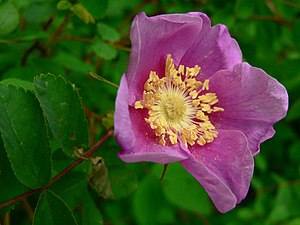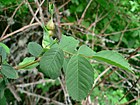Note: This is a project under development. The articles on this wiki are just being initiated and broadly incomplete. You can Help creating new pages.
Difference between revisions of "Rosa nutkana - Wild rose"
m (Prabhakar moved page Wild rose (Rosa nutkana) to Rosa nutkana - Wild rose) |
|||
| Line 1: | Line 1: | ||
[[File:Rosa nutkana 07513.JPG|thumb|right|''Rosa nutkana'', ''Nootka Rose'']] | [[File:Rosa nutkana 07513.JPG|thumb|right|''Rosa nutkana'', ''Nootka Rose'']] | ||
''' | ''' | ||
| − | + | '''Rosa nutkana''' is a 2–10 feet tall perennial shrub in the rose family (Rosaceae). and this plant is native to Western North America. | |
| − | The | + | ==Uses== |
| + | {{Uses|Sore eyes}}, {{Uses|Labor pains}}, {{Uses|Bee stings}}, {{Uses|women's complaints}}, {{Uses|vomiting}}, {{Uses|cancer}}, {{Uses|Diarrhea}}, {{Uses|Sore throats}} | ||
| + | |||
| + | ==Parts Used== | ||
| + | {{Parts Used|Dried Folaige}}, {{Parts Used|Whole herb}}. | ||
| + | |||
| + | ==Chemical Composition== | ||
| + | The compounds quercetin, catechin gallate, quercetin-3-O-glucoside, 1,2,3,4,6-penta-O-galloyl-beta-D-glucoside, and 1,6-digalloyl-beta-D-glucoside exhibited weak antibacterial activity against MRSA<ref name="chemical composition"/> | ||
| + | |||
| + | ==Common names== | ||
| + | {{Common names|kn=|ml=|sa=|ta=|te=|hi=|en=Agrimony}} | ||
| + | |||
| + | ==Properties== | ||
| + | Reference: Dravya - Substance, Rasa - Taste, Guna - Qualities, Veerya - Potency, Vipaka - Post-digesion effect, Karma - Pharmacological activity, Prabhava - Therepeutics. | ||
| + | ===Dravya=== | ||
| + | |||
| + | ===Rasa=== | ||
| + | Tikta (Bitter), Kashaya (Astringent) | ||
| + | ===Guna=== | ||
| + | Laghu (Light), Ruksha (Dry), Tikshna (Sharp) | ||
| + | ===Veerya=== | ||
| + | Ushna (Hot) | ||
| + | ===Vipaka=== | ||
| + | Katu (Pungent) | ||
| + | ===Karma=== | ||
| + | Kapha, Vata | ||
| + | ===Prabhava=== | ||
| + | |||
| + | ==Habit== | ||
| + | {{Habit|Shrub }} | ||
| + | |||
| + | ==Identification== | ||
| + | ===Leaf=== | ||
| + | {{Leaf|Simple||Leaves have 5-7 toothed leaflets, sometimes glandular, with more or less rounded tips}}<ref name="Leaf"/> | ||
| + | |||
| + | ===Flower=== | ||
| + | {{Flower|Unisexual|2-4cm long|Pink|5-20|Nootka Rose has larger flowers that are usually borne singly}} | ||
| + | |||
| + | ===Fruit=== | ||
| + | {{Fruit||1-2cm|Fruits are purplish-red hips|With hooked hairs|}} | ||
| + | |||
| + | ===Other features=== | ||
| + | |||
| + | ==List of Ayurvedic medicine in which the herb is used== | ||
| + | * [[Vishatinduka Taila]] as ''root juice extract'' | ||
| + | |||
| + | ==Where to get the saplings== | ||
| + | ==Mode of Propagation== | ||
| + | {{Propagation|Seeds}}, {{Propagation|Cuttings}}. | ||
| + | |||
| + | ==How to plant/cultivate== | ||
| + | Succeeds in most soils, preferring a circumneutral soil and a sunny position<ref name="How to plant/cultivate"/> | ||
| + | |||
| + | ==Commonly seen growing in areas== | ||
| + | {{Commonly seen|Woods and open places}}, {{Commonly seen|Moderate elevations}}. | ||
| + | |||
| + | ==Photo Gallery== | ||
| + | <gallery class="left" caption="" widths="140px" heights="140px"> | ||
| + | Nootka Rose, San Juan Islands (15127723136).jpg | ||
| + | |||
| + | Rosa nutkana 07439.JPG | ||
| + | |||
| + | |||
| + | Rosa nutkana 07513.JPG | ||
| − | |||
| − | Rosa nutkana | + | Rosa nutkana near Squilchuck State Park Chelan County Washington.jpg |
| + | |||
| − | + | vvBee (23470147929).jpg | |
| + | |||
| + | Bee (23470147929).jpg | ||
| + | |||
| + | Glacier flora8.jpg | ||
| − | |||
| − | |||
| − | |||
| − | + | J20160428-0020—Rosa nutkana—RPBG (26155816703).jpg | |
| + | |||
| + | </gallery> | ||
| − | + | ==References== | |
| − | = | + | <references> |
| + | <ref name="chemical composition">[https://www.ncbi.nlm.nih.gov/pubmed/18066132 "chemical constituents"]</ref> | ||
| − | + | <ref name="Leaf">[http://nativeplantspnw.com/nootka-rose-rosa-nutkana/ "Diagnostic character"]</ref> | |
| − | <ref name=" | + | |
| − | <ref name=" | + | <ref name="How to plant/cultivate">[https://www.pfaf.org/user/Plant.aspx?LatinName=Rosa+nutkana "Cultivation details"]</ref> |
| − | |||
</references> | </references> | ||
| − | == External Links == | + | ==External Links== |
| − | + | * [https://www.wildflower.org/plants/result.php?id_plant=RONU Rosa nutkana on wildflower.org] | |
| − | *[ | + | * [http://www.forthall.net/LC%20Flowers/nootka_rose.htm Rosa nutkana on forthall.net] |
| + | * [http://www.naturalmedicinalherbs.net/herbs/r/rosa-nutkana=nootka-rose.php Rosa nutkana on natural medicinal herbs.net] | ||
| + | * [http://eol.org/pages/231661/details Rosa nutkana on encyclopedea of life] | ||
[[Category:Herbs]] | [[Category:Herbs]] | ||
Revision as of 12:04, 4 June 2018
Rosa nutkana is a 2–10 feet tall perennial shrub in the rose family (Rosaceae). and this plant is native to Western North America.
Contents
- 1 Uses
- 2 Parts Used
- 3 Chemical Composition
- 4 Common names
- 5 Properties
- 6 Habit
- 7 Identification
- 8 List of Ayurvedic medicine in which the herb is used
- 9 Where to get the saplings
- 10 Mode of Propagation
- 11 How to plant/cultivate
- 12 Commonly seen growing in areas
- 13 Photo Gallery
- 14 References
- 15 External Links
Uses
Sore eyes, Labor pains, Bee stings, women's complaints, vomiting, cancer, Diarrhea, Sore throats
Parts Used
Chemical Composition
The compounds quercetin, catechin gallate, quercetin-3-O-glucoside, 1,2,3,4,6-penta-O-galloyl-beta-D-glucoside, and 1,6-digalloyl-beta-D-glucoside exhibited weak antibacterial activity against MRSA[1]
Common names
| Language | Common name |
|---|---|
| Kannada | |
| Hindi | |
| Malayalam | |
| Tamil | |
| Telugu | |
| Marathi | NA |
| Gujarathi | NA |
| Punjabi | NA |
| Kashmiri | NA |
| Sanskrit | |
| English | Agrimony |
Properties
Reference: Dravya - Substance, Rasa - Taste, Guna - Qualities, Veerya - Potency, Vipaka - Post-digesion effect, Karma - Pharmacological activity, Prabhava - Therepeutics.
Dravya
Rasa
Tikta (Bitter), Kashaya (Astringent)
Guna
Laghu (Light), Ruksha (Dry), Tikshna (Sharp)
Veerya
Ushna (Hot)
Vipaka
Katu (Pungent)
Karma
Kapha, Vata
Prabhava
Habit
Identification
Leaf
| Kind | Shape | Feature |
|---|---|---|
| Simple | Leaves have 5-7 toothed leaflets, sometimes glandular, with more or less rounded tips |
Flower
| Type | Size | Color and composition | Stamen | More information |
|---|---|---|---|---|
| Unisexual | 2-4cm long | Pink | 5-20 | Nootka Rose has larger flowers that are usually borne singly |
Fruit
| Type | Size | Mass | Appearance | Seeds | More information |
|---|---|---|---|---|---|
| 1-2cm | Fruits are purplish-red hips | With hooked hairs | {{{6}}} |
Other features
List of Ayurvedic medicine in which the herb is used
- Vishatinduka Taila as root juice extract
Where to get the saplings
Mode of Propagation
How to plant/cultivate
Succeeds in most soils, preferring a circumneutral soil and a sunny position[3]
Commonly seen growing in areas
Woods and open places, Moderate elevations.
Photo Gallery
- VvBee (23470147929).jpg
References
External Links
- Pages with broken file links
- Ayurvedic Herbs known to be helpful to treat Sore eyes
- Ayurvedic Herbs known to be helpful to treat Labor pains
- Ayurvedic Herbs known to be helpful to treat Bee stings
- Ayurvedic Herbs known to be helpful to treat women's complaints
- Ayurvedic Herbs known to be helpful to treat vomiting
- Ayurvedic Herbs known to be helpful to treat cancer
- Ayurvedic Herbs known to be helpful to treat Diarrhea
- Ayurvedic Herbs known to be helpful to treat Sore throats
- Herbs with Dried Folaige used in medicine
- Herbs with Whole herb used in medicine
- Herbs with common name in English
- Habit - Shrub
- Index of Plants which can be propagated by Seeds
- Index of Plants which can be propagated by Cuttings
- Herbs that are commonly seen in the region of Woods and open places
- Herbs that are commonly seen in the region of Moderate elevations
- Herbs







